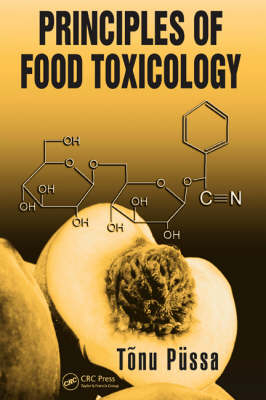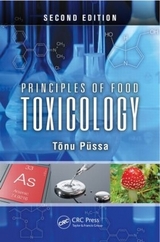
Principles of Food Toxicology
Crc Press Inc (Verlag)
978-0-8493-8090-7 (ISBN)
- Titel erscheint in neuer Auflage
- Artikel merken
While food is an essential source of energy, nutrients, building materials, and even pleasure, it also contains compounds that can potentially evoke greater or lesser health disorders. Toxins can originate from the raw materials or invade during processing, transportation, and storage. They can be intentionally added in the form of "harmless" food preservatives or health-promoting functional ingredients that can become toxic in combination or under environmental stressors. The continuous physical and biochemical processes that food undergoes indicate that there is always the chance for toxicity in even the most innocuous foods.
Skillfully combining theory and applications, Principles of Food Toxicology presents general and food-specific principles of toxicology with vivid examples of food-related poisons and poisonings from around the world. Beginning with an introduction to the principles of toxicology at the molecular, cellular, and organism level, the author uses highly detailed, yet accessible information, to emphasize the biochemical mechanisms of toxic effects. He explains the routes of absorption, metabolism, and elimination; toxic response; the determination of foreign substances; and the evaluation of toxicity and risk analysis. The second part is a systemic characterization of the most important food borne toxicants. The book divides a wealth of information into toxicants from plants and soils, environmental toxins, mycotoxins, marine and animal toxins, pesticide residues, food additives, and toxins that enter food during processing and storage, as well as digestion. The book also includes an extensive glossary.
Drawing from the author's more than 30 years of experience researching and teaching biochemistry and toxicology, Principles of Food Toxicology provides a complete look at the mechanisms and sources of toxicity found in our food sources.
Estonian University of Life Sciences, Tartu, Estonia
BASICS OF TOXICOLOGY CONNECTED TO FOOD
Introduction
What is Toxicology?
Short History of Toxicology
Dose and Response
Interactions of Toxic Substances
Classification of Toxicants
Some Toxicology-Related Principles of Cellular Biology and Biochemistry
Routes of Xenobiotics in Organism
Entry and Absorption of Foreign Compounds
Distribution of the Xenobiotics in the Organism
Metabolism of Xenobiotics
Elimination of Xenobiotics and/or Metabolites from Organism
Biomagnification
Antidotes
Toxic Response
Variability of Toxic Response
Types of Toxic Response
Molecular Mechanisms of Toxicity
Biomarkers of Toxic Effect
Analytical Toxicology Determination of Foreign Compounds
General Principles
Hyphenated Chromatographic and Spectrophotometric Methods
Immunological Methods for Sample Preparation and Analysis
Evaluation of Toxicity of Substances
Epidemiological Studies
Animal Tests
Cell Culture Tests
Computer Calculations
Acute Toxicity Tests
Subacute/Chronic Toxicity Tests
Chronic Toxicity Tests; Acceptable Daily Intake
Other Toxicity Tests
Toxicological Safety and Risk Analysis
Toxicological Safety
Risk Assessment
Internet Sources of Toxicological Information
MAIN GROUPS OF FOOD-BORNE TOXICANTS
Endogenous Plant Toxicants
Lectins or Hemagglutinins; Ricin
Enzyme Inhibitors
Alkaloids
Cyanogenic Glucosides; Toxicity Mechanism of HCN
Phytoestrogens
Glucosinolates
Coumarin
Thujones
Anisatine
Toxic Amino Acids
Toxic Lipids
Oxalates
Fluoroacetates
Bracken toxins
Saponins
Grayanotoxin
Mushroom Toxins
Geochemical Pollutants that a Plant Assimilates from Soil
Arsenic
Selenium
Fluorine
Environmental Pollutants
Toxic Chemical Elements
Radionuclides
Polychlorinated Biphenyls (PCB)
Polychlorinated Dibenzodioxins and Dibenzofurans
Mycotoxins
Overview
Aflatoxins
Ochratoxins
Sterigmatocystin
Zearalenone
Fumonisins
Trichothecenes
Patulin
Citrinin and Citreoviridin
Ergot Toxins
Other Mycotoxins
Combined Toxicity of Mycotoxins.
Animal Endogenous Toxins
Prions
Lactose
Phytanic acid
Avidin
Vitamins of Animal Origin
Food Toxins from Sea
Shellfish Toxicants
Fish Toxins
Pesticide Residues
Overview of Pesticides
Insecticides
Herbicides
Fungicides
Veterinary Drugs and Feed Additives
Antibiotics
Hormones
Other Veterinary Drugs
Toxicants Unintentionally Entering Food during Processing, Storage and Digestion
General
Polycyclic Aromatic Hydrocarbons (PAH)
Alcohols
Bacterial Toxins
Biogenic Vasoactive Amines
Nitrates, Nitrites and Nitrosoamines.
Acrylamide.
Chlorinated Propanols
Phthalates
Bisphenols
Food Additives
Traditional Food Additives
Functional Additives
Vitamins
General Principles
Vitamin A; Phenomenon of Smokers.
Vitamin D
Vitamin E
Vitamin K
Vitamin B2
Vitamin B6
Vitamin C
Vitamin B3
Diagnosing and Therapy of Vitamin Intoxications
Glossary
| Erscheint lt. Verlag | 27.9.2007 |
|---|---|
| Zusatzinfo | 9 equations; 12 Tables, black and white; 65 Illustrations, black and white |
| Verlagsort | Bosa Roca |
| Sprache | englisch |
| Maße | 156 x 235 mm |
| Gewicht | 658 g |
| Themenwelt | Studium ► 2. Studienabschnitt (Klinik) ► Pharmakologie / Toxikologie |
| Naturwissenschaften ► Biologie | |
| Technik ► Lebensmitteltechnologie | |
| ISBN-10 | 0-8493-8090-1 / 0849380901 |
| ISBN-13 | 978-0-8493-8090-7 / 9780849380907 |
| Zustand | Neuware |
| Informationen gemäß Produktsicherheitsverordnung (GPSR) | |
| Haben Sie eine Frage zum Produkt? |
aus dem Bereich



